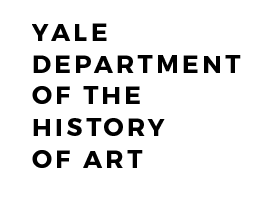Jacqueline Jung
Ph.D., Columbia University, 2002
B.A., University of Michigan, 1993
1991-1992: Ludwig-Maximilians-Universität, Munich
Jacqueline Jung specializes in the art and architecture of medieval Europe, with an emphasis on the figural arts of Gothic France and Germany. My teaching encompasses the history of medieval sculpture; Gothic cathedrals; the body as subject and medium in medieval sources; monumental narrative arts; altarpieces and other liturgical furnishings; visions and visionary experiences; the portrayal and provocation of emotions in medieval art; and approaches to race, gender, and representation in medieval European art. I regularly teach a 100-level course called Art and Architecture of the Sacred: A Global Perspective.
My recent book Eloquent Bodies: Movement, Expression, and the Human Figure in Gothic Sculpture (Yale University Press, 2020), recipient of the Karen Gould Prize from the Medieval Academy of America, offers new ways of looking at monumental sculptural arts in Germany and France, exploring the diverse facets of sensory, physical, and affective experience they arouse. My first book, The Gothic Screen: Sculpture, Space, and Community in French and German Cathedrals, ca. 1200-1400 (Cambridge University Press, 2013), examined the ways in which the lavishly decorated partitions inside Gothic buildings served not only to create discrete liturgical zones but also to connect lay and clerical audiences around a shared focal point.
Forthcoming articles address the interrelations of choir screens and vestments in late medieval churches; Gothic cathedrals as instantiations of the sublime; the importance of the viewer’s perspective in the design of early Netherlandish carved altarpieces; glimmers of women’s agency in didactic and hagiographical manuscript illuminations. A new book, co-written with Isaac Jean-François (PhD candidate in American and African-American Studies) and under contract with MIT Press, explores the surprising resonances in how medieval European and modern Black artists approached bodies, senses, figuration, and transcendence.
In my own research the work of German scholars has been essential, and I have translated several important art historical writings into English, most notably Alois Riegl’s 1899 Historical Grammar of the Visual Arts (Zone 2004). Even with the best efforts of translators (human and virtual), reading knowledge in German is essential for students who work with me. The history of Art History remains of special interest to me, particularly the mediating role of photography, of restoration efforts, and of the nationalist politics of the last century in shaping our understanding of medieval European art. I welcome working with modernists who share these interests and relish looking across a wide time-span for resonances with their work.
Although my own research has centered on Gothic arts in northern Europe, my graduate advising has covered broader terrain. I’ve advised dissertations on German Romanesque portal sculptures and questions of law (Stephanie Luther, 2015); the symbolism and materiality of wood in late medieval altarpieces (Gregory Bryda, 2016, Asst. Prof. at Barnard College; co-advised with Christopher Wood); the links among late medieval reliquaries, automata, and puppets (Michelle Oing, 2020, Visiting Asst. Prof., Pomona College); sculpted Deposition Groups in Spain and Italy (Anabelle Gambert-Jouan, 2023, Asst. Curator of European Art, Dallas Museum of Art); and historiated wooden doors at sites across Europe (Katherine Werwie, 2024, Assoc. Curator, Nasher Museum of Art). Dissertations are underway on performance and authorship in the Manesse Songbook (Dennis Lyle Dechant); speech and inscriptions in the textiles and wall-paintings of late medieval German convents (Kristen Herdman); the material and devotional agency of double-sided painted processional crucifixes in Italian Dominican churches (Stephanie Wisowaty; co-advising with Laurence Kanter); and the goldsmith work of Enrique de Arfe (David Cambronero Sanchez).
As the field of medieval art history and my own teaching trajectory evolve, I look forward to working with students both within Europe and across the vast geographical and cultural terrains of the medieval world. I’m especially eager to learn with people who bring new questions and perspectives to familiar materials, those who are driven to explore areas of medieval art that have fallen between the cracks, and those who explore the affinities, connections, and tensions between the arts of medieval Christian Europe and those beyond its boundaries. The field of medieval art history looks very different today than when I entered graduate school. As a musician friend likes to say, “Play it weird.” So, prospective students: surprise me. Let’s build something new, together.
RECENT PUBLICATIONS (more on my Academia page)
“Caroline Bynum and Medieval Art History in America: Perspectives from an Art Historian and Student.” Common Knowledge 30: 1 (2024): 76-123.
“Unruly Gothic,” in Lateness and Modernity in Medieval Architecture, ed. Alice Isabella Sullivan and Kyle G. Sweeney (Leiden and Boston: Brill, 2023), 423-46.
“Walking to Heaven in Gothic Sculpture,” in Kunstgeschichte(n): Festschrift für Stephan Albrecht, ed. Katharina Christa Schüppel und Magdalena Tebel (Bamberg: University of Bamberg Press, 2023), 12-26.
“In Praise of the Pigeon: Interpretive Adventures at Naumburg Cathedral,” in How Do Images Work? Strategies of Visual Communication in Medieval Art, ed. Christine Beier, Tim Juckes, and Assaf Pinkus (Turnhout: Brepols, 2022), 149-64.
“Gothic Sculpture in France and Beyond,” in Willibald Sauerländer und die Kunstgeschichte, ed. Franz Hefele and Ulrich Pfisterer (Passau: Klinger, 2022), 55-87.
“The Work of Gothic Sculpture in the Age of its Photographic Reproduction,” in The Lives and Afterlives of Medieval Iconography, ed. Pamela A. Patton and Henry D. Schilb (University Park: Pennsylvania State University Press, 2021), 161-94.
